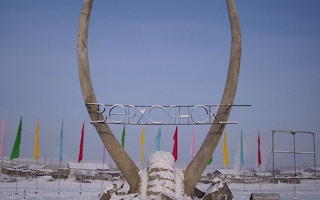An international team of scientists has pinned the strange weather and record heat in the Siberian Arctic firmly on human-induced climate change.
On average, from January to June, temperatures in the region have been 5°C hotter because the world’s cities have continued to consume ever-increasing levels of fossil fuels.
The researchers report that, without human help, such freak conditions could happen only once every 80,000 years or so. But a steady increase in greenhouse gas levels in the atmosphere for the last century or more has increased the chances of record temperatures – one Arctic Circle settlement, Verkhoyansk, normally one of the coldest places on Earth, recorded 38°C on 20 June – by a factor of 600.
“The findings of this rapid research – that climate change increased the chances of prolonged heat in Siberia by at least 600 times – are truly staggering,” said Andrew Ciavarella, of the UK Met Office, who led the study.
“This research is further evidence of the extreme temperatures we can expect to see more frequently around the world in a warming global climate. Importantly, an increasing frequency of these extreme heat events can be moderated by reducing greenhouse gas emissions.”
Confidence grows
That climate change has come to the Arctic is not news: what is significant about the research by British, French, Swiss, Dutch, German and Russian meteorologists is the readiness to put the blame fairly on climate change, even for a freak event.
It has always been a given in the science that the mix of air pressure and temperatures around the world delivers a random pattern of change marked by extremes, and for decades scientists backed away from blaming any single flood, windstorm or heat wave as evidence of climate change. That has, in the last few years, changed.
Research teams have successively warned that climate change driven by human action had contributed to California’s most recent disastrous drought; that both calamitous floods and catastrophic bushfires in Australia were made more probable and more intense by rising greenhouse gas emissions; and that the signature of climate change driven by fossil fuel combustion was now detectable in daily weather changes almost anywhere around the globe.
But the signature of climate change in the Siberian Arctic has been pronounced, and the latest attribution study is confirmation of a new confidence in the data.
“
The findings of this rapid research – that climate change increased the chances of prolonged heat in Siberia by at least 600 times – are truly staggering.
Andrew Ciavarella, senior detection and attribution scientist, Met Office
In June, forest fires in Siberia consumed 1.15 million hectares and released about 56 million tonnes of carbon dioxide: this is more than the annual emissions from Switzerland or Norway.
The rising temperatures in the region have been grounds for extra alarm: permafrost in the Arctic Circle is a store of carbon that is increasingly being released as the ground thaws, to make Arctic warming even worse.
But the hazards of permafrost thaw are also direct: soils become more vulnerable to slip and slump, and there is already measurable damage to the infrastructure once supported by sediments and topsoils that used to be frozen solid all year round.
The region recorded one of the world’s worst oil spills in May, when an oil tank collapsed. The unseasonal and improbable heat has been coupled to an explosion of silk moths, bringing further caterpillar damage to conifer forests.
Even now such temperatures remain unlikely: the human component of climate change has simply reduced the frequency of such sustained temperatures to perhaps once every 135 years.
Little time left
But without rapid and drastic cuts worldwide in greenhouse gas emissions, towns like Verkhoyansk – which also shares the record for the coldest temperature in the northern hemisphere – could become a lot warmer, a lot more often before the century’s end.
“These results show that we are starting to experience extreme events which have almost no chance of happening without a human footprint on the climate system,” said Sonia Seneviratne, of the Swiss Federal Institute of Technology, known as ETH Zurich.
“We have little time left to stabilise global warming at levels at which climate change would lie within the bounds of the Paris Agreement.
“For a stabilisation at 1.5°C of global warming, which would still imply risks of such extreme heat events, we need to reduce our CO2 emissions by at least half until 2030.”
This story was published with permission from Climate News Network.










